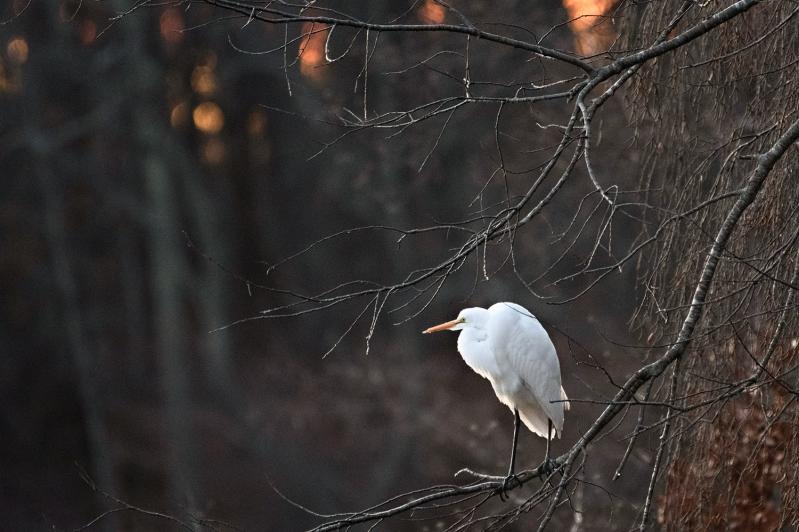In Sag Harbor, an abandoned rail bed forks to a footpath off which a deer trail disappears downslope. Here, surrounded by a thicket, water collects in an unnamed pond covered by a thin green sheet of algae and pollen. Shallow enough that grass pokes through the surface, at dusk this is the green hole where the great egrets gather.
Years ago, I counted 26 there and, proud of my discovery, took my family back the next day to count 28. It’s a wild place, mere yards from a popular trail, a quarter-mile from a busy road. The great egrets settle onto the thin branches of the trees, which bend under their weight, surprised by these large, white Seussian blooms.
Perhaps they surprised Mary Oliver, too, when she came upon a similar place described in her poem, “Egrets.”
And that’s how I came / to the edge of the pond: / black and empty / except for a spindle / of bleached reeds / at the far shore / which, as I looked, / wrinkled suddenly / into three egrets -- / a shower / of white fire!
At nearby Mashashimuet Park, softball practice is ending. Overhead, unnoticed, the egrets slowly beat the breeze, bringing them to this place. I can’t figure out if it’s comforting or alarming that something so large passes undetected above our little human world.
It’s hard to mistake the great egret: lengthy yellow bill, long black legs, large white body in between. They have sinewy necks, sometimes stretched straight, other times tucked into a squat S, as when they’re flying. Last week, I watched one in a muddy puddle of water at the end of Cove Hollow Road and could make out the patch of green between its eye and bill, present only during breeding season.
The other egret in our midst, the snowy egret, is smaller, has yellow feet, and has a frenetic feeding style, jumping and dancing around to rile up the fish below. Great egrets, by contrast, are stately.
It’s the communal nature of these birds that nearly led to their demise 100 years ago. According to allaboutbirds.org, “More than 95 percent of the great egrets in North America were killed for their plumes to decorate hats in the late-19th and early-20th centuries.”
An article in “Birds of America,” written by T. Gilbert Pearson in 1917, begins: “The treatment which man has accorded the egret is not only an evidence of his power over weaker animals, but stands as a blot on this country’s history.”
The only way for hunters to acquire the long plumes was during breeding season, when the egrets were looking after their young. Despite the gunshots, they’d return to care for their babies and were easy marks.
It got to the point that the Audubon Society started to deploy guards to the dwindling breeding areas to prevent the slaughter. Ultimately, the egret became the society’s logo bird. However, when Mr. Pearson was writing, the future was still murky. “It is debatable whether the species can be saved,” he concluded.
Somehow, 100 years later, they’re doing well. The Migratory Bird Treaty Act of 1918 protected them, and their populations rebounded. Without it, we wouldn’t be watching as they arrive in April, when it’s still cold enough that a foul ball off a bat still stings. They start to show up in our freshwater ponds and saltwater marshes just when the forsythia and daffodils are peaking and the goldfinches turn gold again.
I don’t know if any egrets breed locally. In the 1970s, breeding pairs were documented on Gardiner’s and Fishers Islands. I’ve always hoped to find a nest, a pile of sticks high in a tree, somewhere around Crooked Pond, but never have.
I’ve seen a dozen feeding along the North Haven peninsula at low tide, and half that on the mudflats at Mecox and Sagaponack Ponds. They frequent Pussy’s Pond in Springs, too. Last week during the morning drive to school, one flew low over the Lance Cpl. Jordan C. Haerter Memorial Bridge in Sag Harbor, turning heads.
West, at Scallop Pond in Southampton, thankfully preserved by the Nature Conservancy, sometimes 50 or more slowly stalk the marsh during the late summer. To get so big, great egrets eat many small fish. But they have a varied diet, taking crayfish, the odd reptile, and even insects. Back at the green hole, when one flies over the opening, the singing peepers below fall silent. They’re also on the menu.
When hunting, they place their feet gently into the water so as not to create a ripple or disturb the sandy bottom. Often still, their stick-like black legs serve as camouflage as they wait patiently for prey to approach before they jab it from the water.
I’m drawn to places where birds sleep in the way, I guess, that other guys are drawn to car shows. Last week, expecting the egrets back, at sunset, my wife and I walked to the green hole. A single egret huddled on a tree limb. We decided to give it time and walked to Long Pond. As we approached the north end of the pond, tree swallows, as if caught up in some vortex, swept off and vanished over the trees, perhaps off to their own mysterious beds. We walked back to the roost.
The sun had set, and the peepers were at full volume. The trees and trail were being swallowed by the dusk. Two egrets entered the roost together while another circled above. A single tree contained 10 birds. A few preened their feathers that a century ago would have been wiped clean of blood before being sold for 90 cents. Humans.
As the gathering darkness turned the egrets into nothing more than white blobs, we turned to leave. The peepers, safe now, sang them to sleep.

